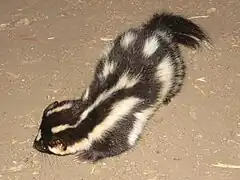| Spilogale | |||
| J.E. Gray, 1865[1] | |||
 Przedstawiciel rodzaju – skunksik smukły (S. gracilis amphiala) | |||
| Systematyka | |||
| Domena | |||
|---|---|---|---|
| Królestwo | |||
| Typ | |||
| Podtyp | |||
| Gromada | |||
| Podgromada | |||
| Infragromada | |||
| Rząd | |||
| Podrząd | |||
| Infrarząd | |||
| Nadrodzina | |||
| Rodzina | |||
| Podrodzina | |||
| Rodzaj |
skunksik | ||
| Typ nomenklatoryczny | |||
|
Mephitis interrupta Rafinesque, 1820 (= Viverra putorius Linnaeus, 1758) | |||
| Synonimy | |||
|
| |||
| Gatunki | |||
| |||
Skunksik[3] (Spilogale) – rodzaj ssaków z podrodziny Mephitinae w obrębie rodziny skunksowatych (Mephitidae).
Zasięg występowania
Rodzaj obejmuje gatunki występujące w Ameryce Północnej – od skrajnie południowej Kanady po Amerykę Centralną[4][5][6].
Morfologia
Długość ciała (bez ogona) 19–37 cm, długość ogona 5,9–28 cm, długość ucha 1,8–3,3 cm, długość tylnej stopy 2–3,4 cm; masa ciała 150–997 g[5][7].
Systematyka
Rodzaj zdefiniował w 1865 roku angielski zoolog John Edward Gray w artykule poświęconej rewizji taksonomicznej skunksowatych ze zbiorów Muzeum Brytyjskiego opublikowanym na łamach Proceedings of the Zoological Society of London[1]. Gatunkiem typowym jest (oznaczenie monotypowe) skunksik plamisty (S. putorius).
Etymologia
- Spilogale: gr. σπιλος spilos ‘cętka, plama’; γαλεη galeē lub γαλη galē ‘łasica’[8].
- Hemiacis: gr. ἡμι- hēmi- ‘pół-, mały’, od ἡμισυς hēmisus ‘połowa’; ακις akis, ακιδος akidos ‘punkt, igła’[9]. Gatunek typowy (oznaczenie monotypowe): Hemiacis perdicida Cope, 1869 (= Viverra putorius Linnaeus, 1758).
Podział systematyczny
Do rodzaju należą następujące występujące współcześnie gatunki[10][7][4][3]:
- Spilogale putorius (Linnaeus, 1758) – skunksik plamisty
- Spilogale interrupta (Rafinesque, 1820)
- Spilogale yucatanensis Burt, 1938
- Spilogale gracilis Merriam, 1890 – skunksik smukły
- Spilogale leucoparia Merriam, 1890
- Spilogale angustifrons A.H. Howell, 1902 – skunksik wąskoczelny
- Spilogale pygmaea O. Thomas, 1898 – skunksik miniaturowy
Opisano również gatunki wymarłe:
Uwagi
Przypisy
- 1 2 J.E. Gray. Revision of the Genera and Species of Mustelidae contained in the British Museum. „Proceedings of the Zoological Society of London”. 1865, s. 150, 1865. (ang.).
- ↑ E.D. Cope. A new series of fossils, from the lime stone caves in the Southern States. „Proceedings of the Academy of Natural Sciences of Philadelphia”. 21, s. 3, 1869. (ang.).
- 1 2 Nazwy zwyczajowe za: W. Cichocki, A. Ważna, J. Cichocki, E. Rajska-Jurgiel, A. Jasiński & W. Bogdanowicz: Polskie nazewnictwo ssaków świata. Warszawa: Muzeum i Instytut Zoologii PAN, 2015, s. 183. ISBN 978-83-88147-15-9. (pol. • ang.).
- 1 2 C.J. Burgin, D.E. Wilson, R.A. Mittermeier, A.B. Rylands, T.E. Lacher & W. Sechrest: Illustrated Checklist of the Mammals of the World. Cz. 2: Eulipotyphla to Carnivora. Barcelona: Lynx Edicions, 2020, s. 450. ISBN 978-84-16728-35-0. (ang.).
- 1 2 J.W. Dragoo: Family Mephitidae (Skunks). W: D.E. Wilson & R.A. Mittermeier (red. red.): Handbook of the Mammals of the World. Cz. 1: Carnivores. Barcelona: Lynx Edicions, 2009, s. 559–561. ISBN 978-84-96553-49-1. (ang.).
- ↑ D.E. Wilson & D.M. Reeder (red. red.): Genus Spilogale. [w:] Mammal Species of the World. A Taxonomic and Geographic Reference (Wyd. 3) [on-line]. Johns Hopkins University Press, 2005. [dostęp 2021-05-22].
- 1 2 Class Mammalia. W: Lynx Nature Books: All the Mammals of the World. Barcelona: Lynx Edicions, 2023, s. 682–683. ISBN 978-84-16728-66-4. (ang.).
- ↑ Palmer 1904 ↓, s. 642.
- ↑ Palmer 1904 ↓, s. 316.
- ↑ N. Upham, C. Burgin, J. Widness, M. Becker, C. Parker, S. Liphardt, I. Rochon & D. Huckaby: Treeview of Mammalian Taxonomy Hierarchy. [w:] ASM Mammal Diversity Database (Version 1.11) [on-line]. American Society of Mammalogists. [dostęp 2023-12-20]. (ang.).
- ↑ J.W. Gidley & Ch.L. Gazin. New Mammalia in the Pleistocene fauna from Cumberland Cave. „Journal of Mammalogy”. 14 (4), s. 351, 1933. DOI: 10.2307/1373954. (ang.).
- ↑ W.W. Dalquest. Early Blancan mammals from the Beck Ranch local fauna of Texas. „Journal of Mammalogy”. 59 (2), s. 291, 1978. DOI: 10.2307/1379912. (ang.).
- ↑ Ch.L. Gazin. The late Cenozoic vertebrate faunas from the San Pedro Valley, Ariz. „Proceedings of the United States National Museum”. 92 (3155), s. 502, 1942. (ang.).
- ↑ C.W. Hibbard. New mammals from the Rexroad Fauna, Upper Pliocene of Kansas. „The American midland naturalist”. 26 (2), s. 342, 1941. DOI: 10.2307/2420965. (ang.).
Bibliografia
- T.S. Palmer. Index Generum Mammalium: a List of the Genera and Families of Mammals. „North American Fauna”. 23, s. 1–984, 1904. (ang.).